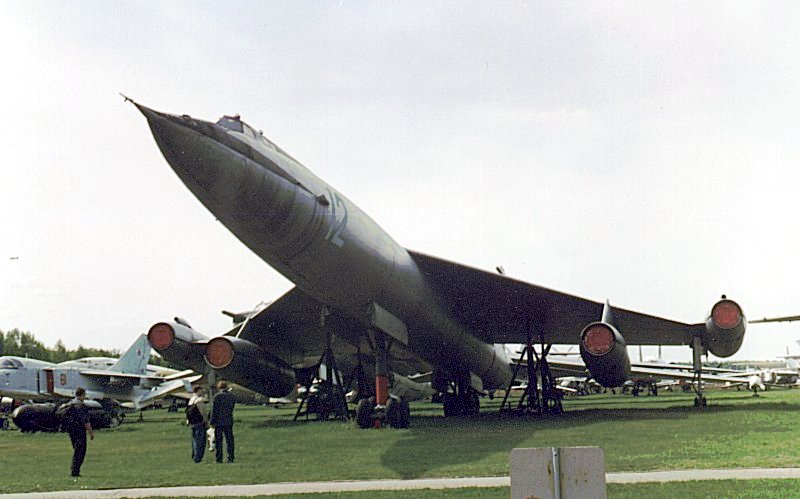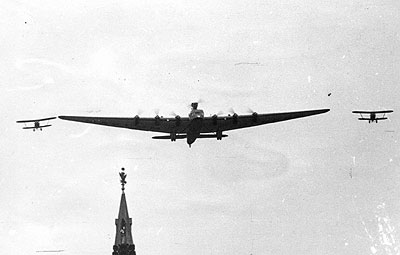|
Tupolev '102'
The Tupolev '102' and Tupolev '101' were 1950s projects for a turboprop airliner and assault transport by the Tupolev Design Bureau. The aircraft designs were almost identical but the '101' had a rear loading ramp and tail barbette for two Nudelman-Rikhter NR-23 cannon. The internal arrangement also differed with the '101' cabin being unpressurised apart from the flightdeck and a small cabin for ten passengers, whilst the '102's pressurised cabin was in one section, configured for 40 passengers. Similar requirements were also issued to OKB-23 ( V.M. Myasischchev) and OKB-473 ( Oleg K. Antonov), resulting in the Antonov An-8 which formed the design root of all Antonov's turboprop transports up to the An-22. Specifications ('102' projected) References {{Tupolev aircraft 1950s Soviet airliners Low-wing aircraft Twin-turboprop tractor aircraft ... [...More Info...] [...Related Items...] OR: [Wikipedia] [Google] [Baidu] |
WikiProject Aircraft
A WikiProject, or Wikiproject, is a Wikimedia movement affinity group for contributors with shared goals. WikiProjects are prevalent within the largest wiki, Wikipedia, and exist to varying degrees within Wikimedia project, sister projects such as Wiktionary, Wikiquote, Wikidata, and Wikisource. They also exist in different languages, and translation of articles is a form of their collaboration. During the COVID-19 pandemic, CBS News noted the role of Wikipedia's WikiProject Medicine in maintaining the accuracy of articles related to the disease. Another WikiProject that has drawn attention is WikiProject Women Scientists, which was profiled by ''Smithsonian Magazine, Smithsonian'' for its efforts to improve coverage of women scientists which the profile noted had "helped increase the number of female scientists on Wikipedia from around 1,600 to over 5,000". On Wikipedia Some Wikipedia WikiProjects are substantial enough to engage in cooperative activities with outside organization ... [...More Info...] [...Related Items...] OR: [Wikipedia] [Google] [Baidu] |
OKB-23
V. M. Myasishchev Experimental Design Bureau (Экспериментальный Машиностроительный Завод им. В. М. Мясищева) or OKB-23, founded in 1951 by MGB UdSSR Vladimir Myasishchev, was one of the chief Soviet aerospace design bureaus until its dissolution in 1960. Vladimir Myasishchev went on to head TsAGI. In 1967, Myasishchev left TsAGI and recreated his bureau, which still exists to this day. The bureau prefix was "M." , its workforce is estimated at approximately one thousand. Myasishchev and NPO Molniya intend to use the V-MT or M-55 as launch vehicle for sub-orbital spaceflight. In July 2014, the merger of Myasishchev and Ilyushin to create a single modern production complex was announced by the Board of Directors of OAO Il. Products 1940-1960 * VM-1/DVB-102: prototype long-range, high-altitude bomber, 1940 **VM-2: projected version of VM-1 with M-20 diesel engines, 1940 **VM-3/DVB-102N: projected ver ... [...More Info...] [...Related Items...] OR: [Wikipedia] [Google] [Baidu] |
1950s Soviet Airliners
Year 195 ( CXCV) was a common year starting on Wednesday (link will display the full calendar) of the Julian calendar. At the time, it was known as the Year of the Consulship of Scrapula and Clemens (or, less frequently, year 948 ''Ab urbe condita''). The denomination 195 for this year has been used since the early medieval period, when the Anno Domini calendar era became the prevalent method in Europe for naming years. Events By place Roman Empire * Emperor Septimius Severus has the Roman Senate deify the previous emperor Commodus, in an attempt to gain favor with the family of Marcus Aurelius. * King Vologases V and other eastern princes support the claims of Pescennius Niger. The Roman province of Mesopotamia rises in revolt with Parthian support. Severus marches to Mesopotamia to battle the Parthians. * The Roman province of Syria is divided and the role of Antioch is diminished. The Romans annexed the Syrian cities of Edessa and Nisibis. Severus re-establish his he ... [...More Info...] [...Related Items...] OR: [Wikipedia] [Google] [Baidu] |
Kuznetsov TV-2
The Kuznetsov TV-2 was an early Soviet turboprop engine, designed by the Kuybyshev Engine Design Bureau. Applications ;TV-2F: Antonov An-8 (proposed) Tupolev '101' (project)Tupolev '102' (project)Tupolev Tu-118 (project) ;TV-2M: Tupolev Tu-91 The Tupolev Tu-91 (NATO reporting name Boot) was a Soviet carrier-borne attack aircraft. It was built only in prototype form, and was converted into a land-based aircraft after Joseph Stalin's death in 1953 cancelled the aircraft carriers being ... (prototype only) ;TV-2T: Antonov An-8 (proposed) Specifications (TV-2F) See also References {{Aeroengine-specs 1950s turboprop engines Kuznetsov aircraft engines ... [...More Info...] [...Related Items...] OR: [Wikipedia] [Google] [Baidu] |
Antonov An-22
The Antonov An-22 "Antei" (, ''An-22 Antej''; English '' Antaeus'') (NATO reporting name "Cock") is a heavy military transport aircraft designed by the Antonov Design Bureau in the Soviet Union. Powered by four turboprop engines each driving a pair of contra-rotating propellers, the design was the first wide-body transport aircraft and remains the world's largest turboprop-powered aircraft to date. The An-22 first appeared publicly outside the Soviet Union at the 1965 Paris Air Show. Thereafter, the model saw extensive use in major military and humanitarian airlifts for the Soviet Union, and is still in service with the Russian Air Force. Design and development In the late 1950s, the Soviet Union required a large military transport aircraft to supplement the Antonov An-8 and An-12s then entering service. Originally known as the An-20, the model is a conventional multi-engined high-wing design. In the early 1960s, the Antonov bureau produced a wooden mock up at its K ... [...More Info...] [...Related Items...] OR: [Wikipedia] [Google] [Baidu] |
Antonov An-8
The Antonov An-8 ( NATO reporting name: Camp) is a Soviet-designed twin-turboprop, high-wing light military transport aircraft. Development In December 1951, OKB-153 initiated the design of a twin-engined assault transport aircraft, designated DT-5/8 (''Desahntno-Trahnsportnyy amolyot' – assault transport aircraft), to be powered by two Kuznetsov TV-2 turboprop engines, and fitted with a large rear cargo door to allow vehicles to be driven straight into the hold.Gordon and Komissarov 2007, p. 4 On 11 December 1953, the Soviet Council of Ministers issued directive No.2922-1251 to the Antonov OKB, requiring them to build a twin-turboprop transport aircraft derived from the DT-5/8. Bearing the in-house designation ''Izdeliye P'' the resulting aircraft had a high wing carrying two turboprop engines, atop a rectangular-section fuselage which could carry 60 troops or 40 passengers. Alternatively. the aircraft could carry a range of vehicles (including ASU-57 assault guns, BTR-40 T ... [...More Info...] [...Related Items...] OR: [Wikipedia] [Google] [Baidu] |
Oleg K
Oleg (russian: Олег), Oleh ( uk, Олег), or Aleh ( be, Алег) is an East Slavic given name. The name is very common in Russia, Ukraine and Belаrus. It derives from the Old Norse ''Helgi'' ( Helge), meaning "holy", "sacred", or "blessed". The feminine equivalent is Olga. While Germanic in origin, "Oleg" is not very common outside Eastern European countries. Russian pronunciation Олег (Oleg) is pronounced �ˈlʲekin Russian. The English pronunciation of Oleg is based on the transliteration of the Cyrillic alphabet, and overlooks three key features of the Russian pronunciation: # The stress is on the second syllable. In spoken Russian, the initial short unstressed 'O' is reduced to � similar to the 'a' as in 'about'. # The 'л' (l) becomes palatalized to ʲ─ that is, it gains a 'y'-like quality, and but is still most closely approximated by a plain English 'l'. # The word-final final 'г' (g) is devoiced to Thus, rather than "Oh-leg", the phonetically c ... [...More Info...] [...Related Items...] OR: [Wikipedia] [Google] [Baidu] |
Nudelman-Rikhter NR-23
The Nudelman-Richter NR-23 is a Soviet autocannon widely used in military aircraft of the Soviet Union and Warsaw Pact. It was designed by A. E. Nudelman and A. A. Richter to replace the wartime Nudelman-Suranov NS-23 and Volkov-Yartsev VYa-23, entering service in 1949. The NR-23 is a single-barrel, short recoil-operated 23 mm (0.90 in) cannon. It was similar to the NS-23 but mechanical improvements increased its rate of fire by more than 50%. Its theoretical rate of fire was 850 rounds per minute, although United States Air Force tests of captured weapons achieved an actual rate of fire of only 650 rounds per minute. The NR-23 was later replaced by the Afanasev Makarov AM-23 automatic cannon which had a higher firing rate. The AM-23 was used in turreted installations for bombers. It was a gas-operated weapon, weighed 43 kg (95 lb) and was capable of a substantially higher rate of fire (1,200–1,300 rounds per minute). The People's Republic of China manuf ... [...More Info...] [...Related Items...] OR: [Wikipedia] [Google] [Baidu] |
WikiProject Aircraft/page Content
A WikiProject, or Wikiproject, is a Wikimedia movement affinity group for contributors with shared goals. WikiProjects are prevalent within the largest wiki, Wikipedia, and exist to varying degrees within sister projects such as Wiktionary, Wikiquote, Wikidata, and Wikisource. They also exist in different languages, and translation of articles is a form of their collaboration. During the COVID-19 pandemic, CBS News noted the role of Wikipedia's WikiProject Medicine in maintaining the accuracy of articles related to the disease. Another WikiProject that has drawn attention is WikiProject Women Scientists, which was profiled by ''Smithsonian Magazine, Smithsonian'' for its efforts to improve coverage of women scientists which the profile noted had "helped increase the number of female scientists on Wikipedia from around 1,600 to over 5,000". On Wikipedia Some Wikipedia WikiProjects are substantial enough to engage in cooperative activities with outside organizations relevant to ... [...More Info...] [...Related Items...] OR: [Wikipedia] [Google] [Baidu] |
Tupolev Design Bureau
Tupolev (russian: Ту́полев, ), officially Joint Stock Company Tupolev, is a Russian aerospace and defence company headquartered in Basmanny District, Moscow. Tupolev is successor to the Soviet Tupolev Design Bureau (OKB-156, design office prefix ''Tu'') founded in 1922 by aerospace pioneer and engineer Andrei Tupolev, who led the company for 50 years until his death in 1972. Tupolev has designed over 100 models of civilian and military aircraft and produced more than 18,000 aircraft for Russia, the Soviet Union and the Eastern Bloc since its founding, and celebrated its 90th anniversary on 22 October 2012. Tupolev is involved in numerous aerospace and defence sectors including development, manufacturing, and overhaul for both civil and military aerospace products such as aircraft and weapons systems, and also missile and naval aviation technologies. In 2006, Tupolev became a division of the United Aircraft Corporation in a merger with Mikoyan, Ilyushin, Irkut, Sukhoi, ... [...More Info...] [...Related Items...] OR: [Wikipedia] [Google] [Baidu] |
Tupolev Tu-101
Tupolev (russian: Ту́полев, ), officially Joint Stock Company Tupolev, is a Russian aerospace and defence company headquartered in Basmanny District, Moscow. Tupolev is successor to the Soviet Tupolev Design Bureau ( OKB-156, design office prefix ''Tu'') founded in 1922 by aerospace pioneer and engineer Andrei Tupolev, who led the company for 50 years until his death in 1972. Tupolev has designed over 100 models of civilian and military aircraft and produced more than 18,000 aircraft for Russia, the Soviet Union and the Eastern Bloc since its founding, and celebrated its 90th anniversary on 22 October 2012. Tupolev is involved in numerous aerospace and defence sectors including development, manufacturing, and overhaul for both civil and military aerospace products such as aircraft and weapons systems, and also missile and naval aviation technologies. In 2006, Tupolev became a division of the United Aircraft Corporation in a merger with Mikoyan, Ilyushin, Irkut ... [...More Info...] [...Related Items...] OR: [Wikipedia] [Google] [Baidu] |




